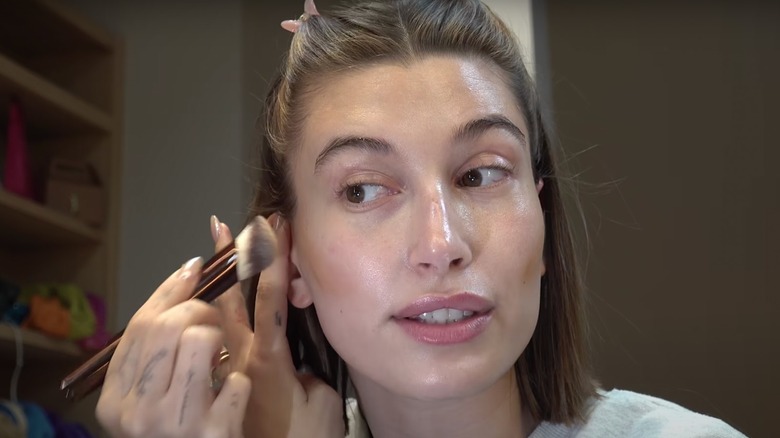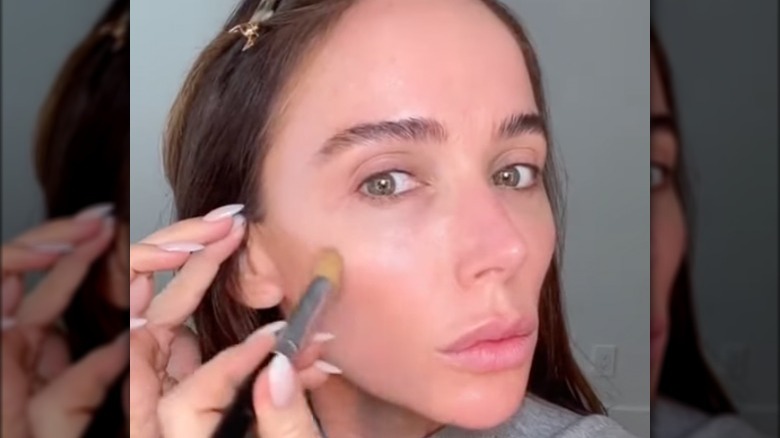The 'Underpainting' Contour Trend Prioritizes Your Inner Glow Over The Makeup
It may be blowing up on TikTok now, but the makeup trend called "underpainting" has actually been around for a long time. In fact, its origins extend beyond modern makeup referring to an old trick Renaissance artists used to brighten up paintings with a base layer. Michelangelo actually used a technique called Terre Verde, where he painted the shadows of a subject's face in an earthy, green color before painting the highlights and flesh tones of the face to create realistic depth (via Curtis Ward). This technique isn't so far off from contouring in the world of makeup, which is simply enhancing the face's natural shadows to create dimension and give a sculpted look.
Typically, we apply contour and blush after our foundation and concealer are on our faces. However, over the years, many makeup artists have taken cues from the art world and applied the principles of underpainting to their technique — applying the color first, foundation second. The result is a more natural-looking finish that lets the richer tones from contour and blush come through from underneath. "This technique is more common than you would think, and it's actually been around forever," makeup artist Megan Dugan told The Zoe Report. "Makeup artists have literally been doing this old-school layering technique for decades to create a soft filtered look." With this very convincing recommendation, let's dig into the how-to of underpainting.
Try it at home
So how does underpainting work? Well, first things, prep your skin as you would on any normal day: moisturizer, SPF, and primer, depending on your normal product use. Then dig right in with the normal cream products you use, be it blush, a contour stick, or highlighter. The beauty of underpainting is that there's no urgency to buy new products. It's simply a case of using familiar ones differently. Makeup artist Carly Giglio told InStyle that the best trick is to start with highlighter. After this, apply contour and blush. "Contour to areas where you want to shade or create depth – the hollows of the cheekbones, down the sides of the nose, the temples," she told the outlet.
Of course, you may be concerned putting the foundation on top will cover up all the color you worked so hard to apply. Fear not. There's a certain trick to the underpainting technique that ensures everything on the bottom layer still shows up in the end. Makeup artist Jenny Patinkin told The Zoe Report, "You'll want to use dense brushes for your under-layers that won't over blend or overly sheer your contour and highlighter." She added, "Then use a very loose fluffy brush to apply your foundation that won't smudge what's been applied underneath." Use a lighter-weight foundation and apply it either using a beauty sponge or a fuller brush and stipple the foundation in that way, so as to reduce moving the base underneath.
Different underpainting tricks
Don't be afraid to play around with the underpainting technique and modify as needed. If you're prone to oily skin and highlighter adds too much shine, feel free to skip it. If blush isn't your jam, try underpainting with a shaded contour instead. In fact, you don't even have to use cream products. Makeup artist Jill Powell told Allure, "You need to make sure that the skin is well-prepped if you're using powders, but you can certainly apply all your contour, blush, and highlight first and then just top it off with a veil of powder foundation." She added, "It'll give you the same lit-from-within look. If you have very oily skin, that could be an option for you."
It might feel counterintuitive at first, but it's worth it to play around with different layers of underpainting until it feels natural. As makeup artist Monika Blunder told Who What Wear: "When done right, the foundation laying on top softens the makeup underneath and almost makes it look like your blush and contour are living under the skin." Sounds like we're on our way to natural, lit-from-within looks.


